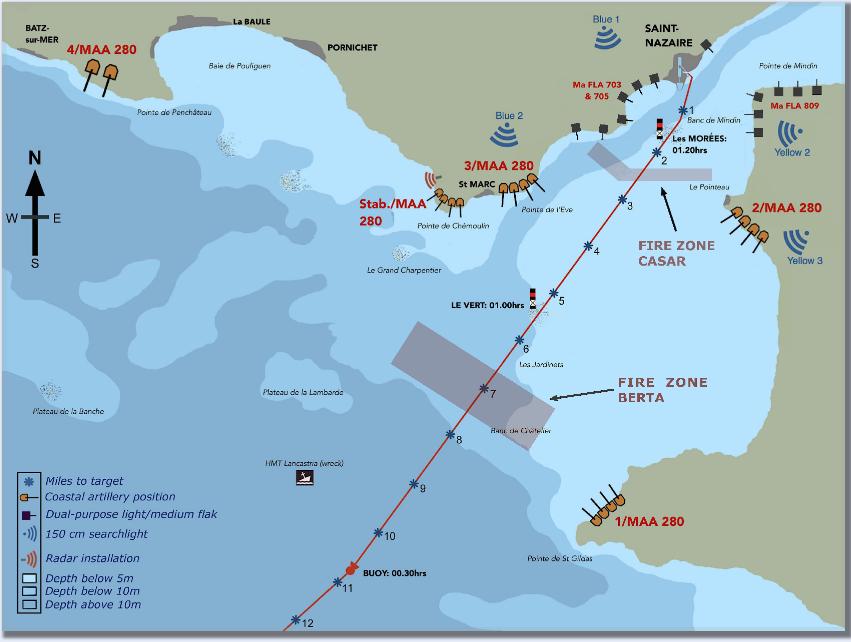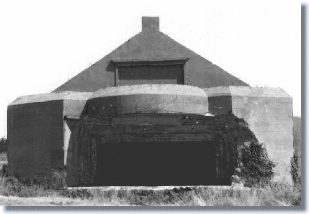 |
||
280 MARINE-ARTILLERIE-ABTEILUNG |
||||||||||
1/MAA 280: Batterie St Gildas (4 x 75mm) 2/MAA 280: Batterie le Pointeau (4 x 75mm) 3/MAA 280: Batterie Behncke-West (4 x 170mm) Stab./MAA 280: Batterie Chémoulin (4 x 150mm) 4/MAA 280: Batterie de Kermoisan ( 2 x 240mm) |
||||||||||
By far the most potent of all the batteries facing the British ships was the Batterie Behncke-west (3/MAA 280), situated atop the Pointe de l'Eve on the site of an old French fort. Consisting of four modern 170mm cannon dispersed in strong concrete bunkers - in the case of the bunker above, disguised as a private home - these were positioned so as to dominate the estuary approaches. Barely visible from sea level even in daylight, these would have wreaked havoc amongst the approaching columns - had they been spotted in time. However their limited eastward traverse meant they could not fire effectively in the direction of the harbour once the enemy ships had passed by. As evidenced above, futile attempts were made to improve the traverse by attacking the concrete with jackhammers. |
||||||||||
 |
||||||||||
 |
 |
|||||
(Korvettenkapitän Edo-Friedrich Dieckmann commanding)
22.MARINE-FLAK-REGIMENT
(Kapitän-zur-See Karl-Conrad Mecke commanding)
703 Marine-Flak-Abteilung (Korvettenkäpitan Hans Thiessen)
705 Marine-Flak-Abteilung (Korvettenkapitän Curt Koch)
809 Marine-Flak Abteilung (Korvettenkapitän Lothar Burhenne)
(All with 20mm, 37mm and 240mm dual-purpose mountings)
The Estuary Approach
00.25hrs: Saturday March 28th. The ships pass the wreck of the troopship Lancastria, sunk in 1940. They are on time, and on course: now a mere 11 miles from the 'Normandie' Dock - and still undiscovered by the port's defenders.
00.45hrs: Campbeltown grounds twice, in the area of La Châtelier shoal. The north shore becomes visible, and overhead some bombers are heard making for home.
01.00hrs: even though the bombers have gone, Mecke's batteries remain on alert. A patrol vessel sights the force but has no radio on board! The force is also sighted by the commander of the 809th Flak Battalion - but his report is disbelieved.
01.15hrs: the force is reported again, this time by a lookout at St Marc. Enquiries confirm these are not the German destroyers sent to sea earlier in response to Kaleu Kelbling's report.
01.20hrs: by now the first ships are passing Les Morées light tower, a mere two miles from target. Mecke finally gives the 'Beware Landing' signal and Emergency Orders come into force to repel an assault.
01.23hrs: the force is challenged by signal, from within the port, and from the Batterie Behncke-West. Genuine SIGINT obtained by Intelligence keeps the German batteries confused. Desultory firing soon ceases.
01.28hrs: the German defenders are fooled no longer and fire is opened by both sides, Campbeltown replacing her German ensign with the White Ensign. The British ships are now fully in the narrows and close-range fire is particularly damaging to the wooden Coastal Forces launches. But the lead ships are now in the harbour approaches, and the chance to stop their assault has been missed.
MGB 314 is first to penetrate the harbour proper, and engage the German guard-ship Sperrbrecher 137, stationed just off the harbour's East Jetty, right in the line of approach. As other launches come within range they too engage her and she is soon on fire.
01.28 - 01.34hrs: ML 156 is hit in the bridge, wounding her captain, Lieutenant Leslie Fenton, and Commando party leader Captain Richard Hooper - amongst others. ML 446 is hit amidships killing Captain Bertie Hodgson, leader of her particularly vital Commando Assault Party. Given that she is the most prominent ship, fully illuminated by powerful searchlights, HMS Campbeltown is repeatedly hit. In her armoured bridge, Lt. Commander Sam Beattie, his view obscured by smoke, searchlights and shell-bursts, suddenly realises he is steering for the lighthouse at the tip of the harbour's East Jetty rather than the lighthouse at the tip of the Old Mole. A violent correction to starboard, onto course 055 degrees, brings the old destroyer back onto her designated route to the caisson. Meanwhile the gunboat also hauls round to starboard, to clear the destroyer's bow.
Now precisely on course, Beattie clears the tip of the Mole and brings Campbeltown round to 350 degrees. Lying behind their armoured screens on deck amidships, and gathered in the Wardroom below the bridge, her Commando parties ready themselves for the expected hail of enemy fire once they break cover. Now making 20kts, Campbeltown tears through the dock's protective torpedo net and strikes the 'Normandie' dock caisson dead-centre, her velocity carrying her over and across its nine metre width - exactly as planned. It is now 01.34hrs, and she is a mere four minutes behind schedule having achieved something widely thought to be impossible.
As naval parties complete the process of scuttling the destroyer so she cannot be towed away, the Commando parties stream forward into the expected hail of fire from nearby, gun positions, and down the waiting ladders onto the torn caisson surface. It is too late to stop them now, and, with the enemy gun positions speedily silenced, the all-important shore facility demolitions can begin.
Astern of Campbeltown the story is, as demonstrated by the image below, altogether less heartening as the launches succumb, one by one, to punishing, point-blank, enemy fire......
An ML smoulders in the shallows west of the Avant Port
The Estuary Gun Defences
All material contained in this site is subject to copyright and must not be reproduced in any format without the consent of the relevant copyright holder
NB: the port and estuary also housed powerful dedicated Flak batteries. As these were not involved in the action once the bombers had withdrawn they are, for the sake of clarity, not included in the above illustration
